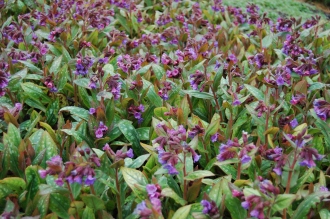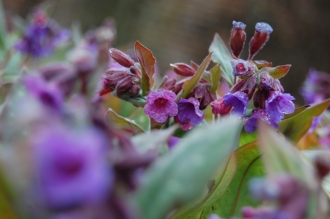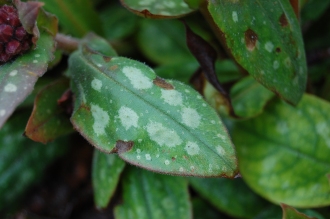Position: Partial sun to full shade
Flowering period: Late winter to Spring
Soil: Moist, well drained
Eventual Height: 30cm
Eventual Spread: 60cm
Hardiness: 4a, 4b, 5a, 5b, 6a, 6b, 7a, 7b, 8a, 8b, 9a, 9b
Family: Boraginaceae
Pulmonaria saccharata is a low growing, spreading, semi-evergreen herbaceous perennial with a clump forming habit. Its dark green leaves are lanceolate with entire margins, have silver spots and are arranged in rosettes. Their upper surface is quite hairy. Its purple/ pink hermaphrodite flowers are 5 petaled and lobed, with a tubular corolla, 5 stamens and are produced in small bunches on long stalks just above the foliage in spring. The fruit is a dry drupe or nutlet. The roots are rhizomes which aid its spread.
Pulmonaria saccharata, commonly known as Lungwort, Bethlehem Sage or Jerusalem Sage, is native to France and Italy.
The etymological root of the binomial name Pulmonaria is derived from the Latin pulmo ‘lungs’ in reference to its historic use. Saccharata is from the Latin meaning ‘sugared’, in reference to its leaf’s white hairy coating.
The landscape architect may find Pulmonaria saccharata useful as an effective ground cover perennial suitable for woodland or understory planting as it can tolerate full shade. The plant may die back in hot dry periods and will recover when the temperature falls. This plant is not attractive to deer.
Ecologically, Pulmonaria saccharata is attractive to pollinating insects. Its leaves are eaten by the caterpillars of some moths.
The Royal Horticultural Society has given the group Pulmonaria saccharata Argentea Group their prestigious Award of Garden Merit in 1993.
Pulmonaria saccharata prefers moist, fertile, humus rich, well-drained soils. It tolerates most pH of soil.
Pulmonaria saccharata requires little maintenance. Large clumps may be lifted and divided in autumn.







Leave a comment